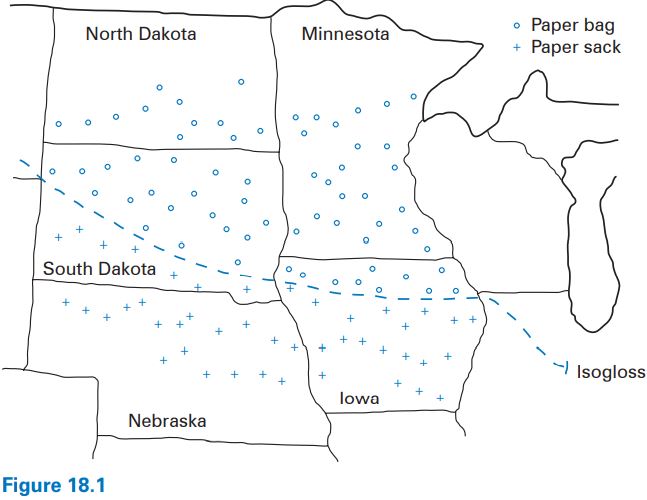
Isoglosses and dialect boundaries
 المؤلف:
George Yule
المؤلف:
George Yule
 المصدر:
The study of language
المصدر:
The study of language
 الجزء والصفحة:
242-18
الجزء والصفحة:
242-18
 7-3-2022
7-3-2022
 5668
5668
Isoglosses and dialect boundaries
We can look at some examples of regional variation found in a survey that resulted in the Linguistic Atlas of the Upper Midwest of the United States. One of the aims of a survey of this type is to find a number of significant differences in the speech of those living in different areas and to be able to chart where the boundaries are, in dialect terms, between those areas. If it is found, for example, that the vast majority of informants in one area say they carry things home from the store in a paper bag while the majority in another area say they use a paper sack, then it is usually possible to draw a line across a map separating the two areas, as shown on the accompanying illustration. This line is called an isogloss and represents a boundary between the areas with regard to that one particular linguistic item.
If a very similar distribution is found for another two items, such as a preference for pail to the north and bucket to the south, then another isogloss, probably overlapping the first, can be drawn on the map. When a number of isoglosses come together in this way, a more solid line, indicating a dialect boundary, can be drawn.
In the accompanying illustration, a small circle indicates where paper bag was used and a plus sign shows where paper sack was used. The broken line between

the two areas represents an isogloss that roughly coincides with lines separating several other linguistic features. Using this dialect boundary information, we find that in the Upper Midwest of the USA there is a Northern dialect area that includes Minnesota, North Dakota, most of South Dakota and Northern Iowa. The rest of Iowa and Nebraska show characteristics of the Midland dialect. Some of the noticeable pronunciation and vocabulary differences are illustrated here.

So, if an American English (male) speaker pronounces the word greasy as [ɡrizi] and asks for a bucket to carry water, then he is not likely to have grown up and spent most of his life in Minnesota. While making this general claim, we shouldn’t forget that, although the characteristic forms listed here were found in the speech of a large percentage of those interviewed in the dialect survey, they won’t necessarily be used by all speakers currently living in the region.
 الاكثر قراءة في Linguistics fields
الاكثر قراءة في Linguistics fields
 اخر الاخبار
اخر الاخبار
اخبار العتبة العباسية المقدسة


